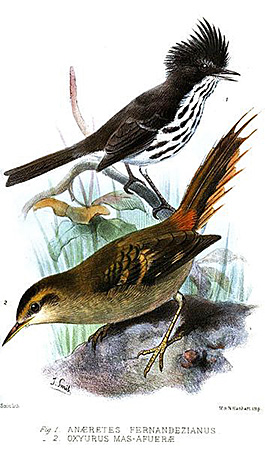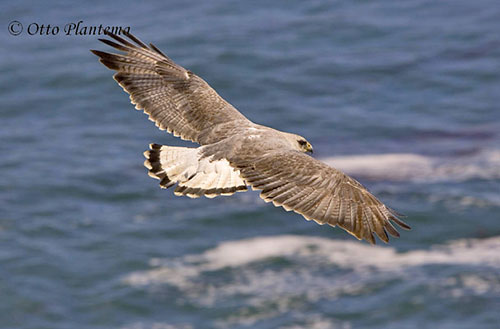
Fr: Synallaxe de Masafuera
Ang: Masafuera Rayadito
All: Inselschlüpfer
Esp: Rayadito de Más Afuera
Ita: Rayadito di Mas Afuera
Nd: Masafuerarayadito
Sd: alejandroselkirktörnstjärt
Photographers:
Otto Plantema
Trips around the world
Philippe et Aline Wolfer
GALERIE
Illustrations:
Joseph Smit: 1836-1929
Source: https://archive.org/details/ibis13brit/page/180/mode/2up?view=theater
Text by Nicole Bouglouan
Sources:
HANDBOOK OF THE BIRDS OF THE WORLD Vol 8 By Josep del Hoyo-Andrew Elliott-David Christie - Lynx Edicions - ISBN: 8487334504
BIRDS OF SOUTH AMERICA – Passerines - by Robert S. Ridgely and Guy Tudor – HELM Field Guides – ISBN: 9781408113424
Endemic breeding birds of Juan Fernández archipelago, Chile
New observations of the Masafuera Rayadito Aphrastura masafuerae
VOCALISATIONS OF THE MÁSAFUERA RAYADITO APHRASTURA MASAFUERAE ON ISLA ALEJANDRO SELKIRK, CHILE
Mongabay - Genetics study sheds light on Chile’s most endangered bird
BEHAVIOR OF BROOD-CARING MÁSAFUERA RAYADITOS IN THE PRESENCE OF AVIAN PREDATORS
New observations of the Masafuera Rayadito Aphrastura masafuerae on Isla Alejandro Selkirk
Chili : cinq faits sur la conservation du synallaxe de Masafuera (Rayadito de la isla Selkirk)
Wikipedia, the free encyclopaedia
Masafuera Rayadito
Aphrastura masafuerae
Passeriformes Order – Furnariidae Family
INTRODUCTION:
The Masafuera Rayadito is endemic to Alejandro Selkirk Island (formerly Isla Más Afuera) in the Juan Fernández Archipelago, off C Chile.
The species usually ranges in the dense understorey dominated by the tree-fern Dicksonia externa, and often along streams, between 600 and 1,300 metres of elevation. It feeds mainly on arthropods found on fern fronds or in epiphytic mosses and lichens.
The Masafuera Rayadito is often seen in pairs and both partners remain continuously in vocal contact. The nesting habitat is above 1,200 metres of elevation in fern strands. This species nests in small natural holes in trees and steep rock walls. Both parents feed the chicks.
The Masafuera Rayadito is the second member of the genus Aphrastura, the other one is the Thorn-tailed Rayadito of South America mainland.
The Masafuera Rayadito is affected by habitat degradation by goats, but fires and timber-cutting also destroy the habitat of this species, especially the mature trees. Introduced mammalian predators also have a negative impact.
The small population appears fairly stable, but the Masafuera Rayadito is currently listed as Critically Endangered.
DESCRIPTION DE L’OISEAU:
Biometrics:
Length: 14-16 cm
The Masafuera Rayadito resembles the Thorn-tailed Rayadito, but it is slightly larger with longer tail, longer bill and much duller plumage.
The Masafuera Rayadito has dull brown back and rufous-brown rump. On the upperwing, the blackish wing-coverts have tawny tips (paler in worn plumage). The blackish flight-feathers show dull rufous bases. The graduated tail has stiff shafts and the barbs are reduced distally involving a “spiny” appearance. The webs are rufous and all rectrices except the central pair have blackish bases.
On the underparts, chin and throat are whitish. Breast and belly are dull, buffy grey-brown with rufescent wash. Flanks and undertail-coverts are rufescent.


On the head, the forehead is whitish with some narrow, rufous streaks. The crown is dark dusky brown. We can see a poorly defined dull, buff-brown supercilium.
The two-tone bill has horn-brown or horn tinged yellowish-white upper mandible. This difference may represent sexual characteristics. The lower mandible is yellowish-brown.
The eyes are brown. Legs and feet are yellowish-grey.
Male and female are similar, with possibly some differences in colour of crown and upper mandible.
The juvenile is undescribed because nest and brood are placed inaccessibly within the rock and not visible.
RANGE:
The Masafuera Rayadito resides on Alejandro Selkirk Island in Juan Fernández Archipelago, off C Chile.
HABITAT:
The Masafuera Rayadito frequents thick undergrowth in semi-humid to humid montane scrub, and also wooded areas, especially with Dicksonia externa tree-fern, often along streams in patches of canelo tree Drimys confertifolia (family Winteraceae). It is usually present between 800 and 1,300 metres of elevation. During the austral winter, it often descends as low as 400 metres.
During the breeding season, the Masafuera Rayadito is mainly found in autochthonous fern strands of the alpine summit region. The only dominant species above 1,100 metres is the fern Lophosoria quadripinnata, growing only 1-1,50 metre tall, but it provides 95/100% cover.
The Masafuera Rayadito also breeds in two other habitat types, but only above 800 metres. Various tree-fern species of about 5 metres tall are growing in these habitats. Some of them are growing on steep rock walls and canyon sides, on wet sites.

To compare the two species
CALLS AND SONGS: SOUNDS BY XENO-CANTO
The Masafuera Rayadito produces three vocalisation types including the common call, the alarm call and the song.
The common call is uttered singly or in series with regular pauses. It is a low churring “trrrt”. This call seems to be used as contact with partner or to advertise the territory.
The alarm call is a series of continuous similar notes without pauses.
The song is given by only one member of the pair, exclusively in the morning before sunrise. It consists of only one type of phrase which is repeated, but with regular pauses.
All these vocalisations, although different from each other, have monotonous structure and repetition of phrases or notes.
BEHAVIOUR IN THE WILD:
The Masafuera Rayadito probably feeds mainly on arthropods such as spiders and larvae of Lepidoptera.
It forages on fern fronds and occasionally on epiphytic mosses and lichens growing on Winteraceae species, often Drimys confertifolia. It progresses slowly with hops and short flights, also upwards the trunks with the long hind claws pointing outwards. It may also hang upside down while searching for prey on the underside of twigs. Occasionally, it can be seen searching for food by scratching in the leaf-litter. They are often seen in pairs.

Similar feeding behaviour
The breeding behaviour of this species is poorly known. The nest is located within the rock and invisible, due to the small opening of 3 cm in diameter.
The duration of the breeding period seems to be related to food availability. Both parents forage and feed the young. They are monogamous.
The Masafuera Rayadito is very territorial and advertises with a strong, buzzy-like sound. While calling, the bird puffs up the body feathers and slightly spreads the wings.
The Masafuera Rayadito often changes location, probably to avoid detection by the local Variable Hawk. While the rayadito is moving under the fern cover, the predator is often seen flying just above, apparently hunting the small birds.
When in dense vegetation, the Masafuera Rayadito approaches predators to within a few metres. It is constantly “churring” while hopping between ferns. During this behaviour, the graduated spiny tail is continuously cocked while the bird rotates laterally with depressed wings, in order to display their pattern. Such sequences may last several minutes.

The Masafuera Rayadito is resident and only performs some altitudinal movements in winter.
The flight is acrobatic and active while it is searching for prey. Often restless, the bird only performs short duration and distance flights.
REPRODUCTION OF THIS SPECIES:
The breeding season takes place (at least) from early December to late January.
The Masafuera Rayadito nests in forested areas at high elevations, in deep ravines and cliffs. The nest is built in small cavities in steep rock face, usually at least five metres above the surrounding ground. The opening is approximately 3 cm in diameter and the depth of the hole is about 65 cm and sloping a little downwards. The entrance is natural, determined by the rock structure and not modified by the birds.
As the inner part of the nest is not accessible, it is not known if nest materials are added or not.
However, nest-boxes have been installed in various habitats in 2006. Inside the boxes, the nests show a supporting structure of canelo and tree-fern rootlets. The cup is lined with petrel feathers.
The female lays 2-3 white eggs. Two family groups have been observed, one with two adults and two juveniles, and a second one with two adults and only one juvenile.
From observations in January 1995, the duration of the nesting period ranges from at least 17 days to a maximum of 27 days. Both parents feed the chicks in similar proportions.
The Variable Hawk is the main predator of this species and its nest.
The raptor has been observed hovering at two nest entrances and snatching with its talons into the nest hole. Later, it was seen perched on top of the rock. But because of the small size of the nest opening, and the hard rock substrate, the attacks were not successful.

PROTECTION / MENACES / STATUS:
The Masafuera Rayadito is threatened by habitat fragmentation and degradation caused by goat-trampling, fires and timber-cutting.
Introduced mammalian predators such as cats, rats and mice may have a significant impact on the population.
The numbers of the Variable Hawk have increased during the last decade. It is known preying on rayaditos, but also on introduced mammals.
The population is roughly placed in the band 50/249 mature individuals, rounded to 70/400 individuals. Following a rapid decline in the mid-1980s and early 2000s, the numbers seem to have stabilised at around 140 individuals.
The future of this species is probably secure for as long as large tracts of the ferns Dicksonia externa and Lophosoria quadripennata remain.
The Masafuera Rayadito is currently listed as Critically Endangered.
Juan Fernandez Tit-Tyrant
Joseph Smit : 1836-1929